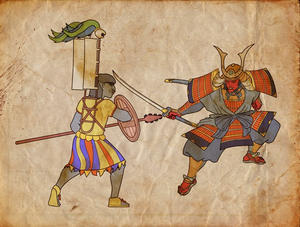1585 Itzatlán raids
This article is incomplete because it is pending further input from participants, or it is a work-in-progress by one author. Please comment on this article's talk page to share your input, comments and questions. Note: To contribute to this article, you may need to seek help from the author(s) of this page. |
| 1585 Itzatlán raids | |||||||
|---|---|---|---|---|---|---|---|
 An artist depiction of a Xaliecan warrior fighting one of the sen-ōkami | |||||||
| |||||||
| Belligerents | |||||||
| Ahuitzotl II's Xaliecan remnant | Hōrō-zō | ||||||
| Commanders and leaders | |||||||
| Ahuitzotl II | Fuwa Kazuemon Masatane | ||||||
| Strength | |||||||
|
Around 1,600-2,000 warriors |
2 junks 150 tops Hōrō-zō | ||||||
| Casualties and losses | |||||||
|
450-550 casualties Unknown number of native allies killed or injured. | Around 70-80 casualties | ||||||
The 1585 Itzatlán raids were a series of clashes between a Xaliecan remnant led by the self-proclaimed tlatoani of the Xaliecan Empire, Ahuitzotl II, and masterless Hōrō-zō headed by Fuwa Kazuemon Masatane. These raids, which took place in the vicinity of the ruins of Itzatlán, finally resulted in a Xaliecan victory.
This event is a recorded battle between the recently-conquered but traditionalist Xaliecan warriors against heavily experienced Hoterallian Sen-ōkami. The raids are still considered one of the strangest events in Anterian history due to how surreal it was.
Background
In 1521, the Canterian conquest of the Xaliecan Empire concluded with the majority of the Xaliecan Empire and its capital, Tlaxomolco being destroyed and Gran Rugido officially became the Vicerroyalty of New Canteria. By the 1570s, remnants of the Xaliecan Empire remained as unorganized but lethal groups. One of these was led by Ahuitzotl II, one of the many self-proclaimed tlatoani of his specific remnant. Ahuitzotl II was inherited with Xaliecan knowledge by his grandfather, José Miguel Maxixcatl and was already in a truce with the Tarascan Confederacy during the Canterian conquest of Tectetán, supporting the natives periodically.
In 1582, Ahuitzotl II's remnant came across the ruins of the Didxažon capital of Itzatlán, where the first Canterians arrived in 1519 and established the now abandoned colony of Santiago de Pascua. Ahuitzotl, knowing the potential of the ruins and their hisotry decided to establish the new capital of his remnant nearby the former ruins, creating the small settlement known as Mitla (Xaliecan: Place of the dead) in the former place of the Canterian fort. In the following years, the Xaliecan remnant was armed with a combination of arquebuses, traditional macuahuitls, and atlatls to defend themselves from any possible Canterian raids.
In 1583, Fuwa Kazuemon Masatane and his group of sen-ōkami lost their master, Kuwabatake Sanjuro of the Sanjuro Domain, resulting in the group becoming hōrō-zō, masterless sen-ōkami. The group was banished from their former master's domain, wandering the country before obtaining two junks and leaving the country. The group turned into petty thieves and muggers, ransacking small port cities before being lost at sea.
Prelude
According to records kept by the group, they were lost for over five months. Lacking morale and malnourished, the group's junks ran aground a beach in early January 1585. The Xaliecan calendar and the Figueroa Codex records the arrival of "people from the Mictlán" around the 8-Malinalli of the 1-Tecpatl (6 January 1585).
The group resorted to raids on the seashores of Gran Rugido, particularly near the ruined city of Itzatlán.
These raids were on a constant basis. Raids for food, drinking water, and sometimes valuable loots were also taken. Their time of being thieves and raiders helped in many successful looting. Their raids were ruthless, killing civilians and burning houses, resulting in casualties of many of the Gran Rugidoense natives.

